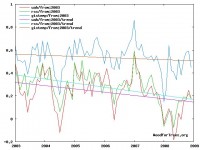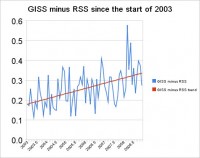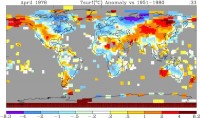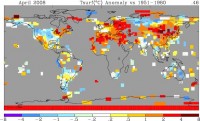Jan 24, 2009
Profiles in Cowardice
By Paul Chesser in the American Spectator
The intimidation tactics and belittling words of those in global warming alarmism are only a means to cloak the weaknesses of their arguments, especially now that the scientific and economic evidence has found a broader, more receptive audience—check the latest poll results if you don’t believe me.
Put succinctly, their efforts to silence opposing viewpoints to their dogma have only proven that they are a bunch of chicken-twits. Now that doubting Dorothy has doused Elmira Gulch’s other ego with a cocktail of moderating temperatures and an economy in distress, the cries that their forecasts are “melting, melting, aagghhhh” approach a shrill peak.
What has happened in Arkansas the last few weeks is illustrative. The story starts, as is the case in so many states, with Gov. Mike Beebe’s (video link) creation of the Governor’s Commission on Global Warming. In most other states where they’ve been developed, these panels have been fashioned purely by executive fiat. Arkansas’s GCGW was authorized also by a law (PDF) to study potential impacts of global warming and ways to mitigate greenhouse gas emissions (the presumed evil behind global temperature uptick). But the GCGW was also given the mandate to “study the scientific data, literature, and research on global warming to determine whether global warming is an immediate threat to the citizens in the State of Arkansas….”
Turns out this area of “study” was only allowed to go so far. As is the standard when the Center for Climate Strategies is granted management control of a state’s climate commission (approaching two dozen so far), the prerequisite for CCS to take the job is that no debate of the climate science is allowed. Like the intolerant Al Gore, CCS cannot suffer dissent, flat-earthers, or moonwalk-deniers.
As 2008 closed, syndicated columnist David Sanders of roughly two dozen Arkansas newspapers trained his critical eye upon the sham process that was the GCGW. And again. And again. And again. And again. And again. Yes, six (6) times. As Dr. Ford sounded warnings about the GCGW with legislators, Sanders’s reports drew out others on the commission with similar gripes.
“The commission members themselves weren’t as big of participants as was CCS, quite frankly,” said Gary Voigt, president of the Electric Cooperatives of Arkansas. “Commission members didn’t have the input; CCS’s consultants had most of the input. There was a structure and a goal.” “As a commissioner,” said Kevin Inboden of Jonesboro’s city and water utility, “when I hear that the commission recommended this or that, it doesn’t tell the whole story. There was a lot of dissension and opposition.”
The piece de resistance of the resistance came in a legislative hearing held last week in Little Rock, in which famed atmospheric scientist skeptic Roy Spencer, “Red Hot Lies” author Chris Horner, and two myth-busters from the Science and Public Policy Institute delivered multiple puncture wounds to global warming alarmism. As a local left-wing blog threw apoplectic fits, a Democratic Senate committee chairman tried to shut the meeting down. But the pressure brought by Sanders, the scheduled skeptics, and the bold dissenters on GCGW was too much, and the hearing was held.
The Arkansas scenario was a microcosm of the alarmists’ flailing on the issue globally. The more they try to silence their opposition, and portray them as unworthy of contemplation while positing their own outrageous doomsday scenarios, the further they push themselves to the fringe in public perception. That so many who hear these calamity predictions are freezing their keisters this winter doesn’t help the warming cause.
Before long the alarmists who have so desperately and cowardly avoided debates will be begging for them, so they can recover their evaporated credibility. Read full account here.
Jan 23, 2009
Real Climate [Gavin Schmidt] Response To The Climate Science Post “Comments On Real Climate’s Post “
By Roger Pielke Sr., Climate Science
Gavin’s statement, with respect to our NRC committee, that “It remains a puzzle to me why you thought the proposed report would be something related to the IPCC report at all” is quite astonishing. Gavin Schmidt has responded to the Climate Science request for further information on the Q&A he completed on climate modeling. Quite frankly, I am very disappointed by his lack of professional courtesy. He also clearly wants to avoid answering the scientific questions posed in response to his Q&A. He has also decided to misrepresent the NRC meeting. His comment is below.
[Gavin Schmidt Response [see Comment #148]:The balance between justifiable criticism and unjustifiable comments is a fine line (and assessing it is a full time job). Given this is only a part time gig, there will be times when judgment calls go different ways at different times. On balance, I’m going to allow Bloom’s comments to stand (along with your critique) because he alludes to a valid point - not that behaviour or attitude determines the correctness of ones argument (it doesn’t), but that the way one behaves towards colleagues is a big determinant of how much time people will devote to addressing your concerns. Roger’s post on the NRC meeting was very odd, full of unverifiable and untrue suppositions of motives of the people there, and which did not reflect the substantive conversations that actually took place there (which concerned solar impacts on climate, not evaluating the IPCC). It is valid to point this out, as it is valid to note that people need to choose who to interact with (given the limited time everyone has). Respect is very much a two way street. - gavin]
I am only going to respond to the one substantive issue that Gavin raises; he writes: “The NRC meeting I attended was a discussion of whether a new report on solar-climate interactions would be helpful for the NRC to do. Most presentations focussed very specifically on solar-climate links. It remains a puzzle to me why you thought the proposed report would be something related to the IPCC report at all.”
To refute Gavin’s claim, I cut and paste below from the strawman document that was circulated prior to the meeting and which we discussed at the NRC meeting; it reads [ the strawman is reproduced in its entirety in Protecting The IPCC Turf - There Are No Independent Climate Assessments Of The IPCC WG1 Report Funded And Sanctioned By The NSF, NASA Or The NRC.]
“In order to understand the solar influence on climate and the atmosphere, it is essential to also understand the contributions of volcanic aerosols, as well as anthropogenic greenhouse gases and tropospheric aerosols, and other human influences such as land use changes, all of which contribute to the observed climate. Furthermore, because there is growing evidence that responses of the climate system to these various influences likely engages and modifies existing circulation patterns, it is necessary to understand pervasive climate processes (e.g., ENSO, NAO, QBO) and centers of action, and their responses to radiative forcings.
Also in need of clarification is the current wide disparity regarding how to achieve and quantify attribution. IPCC studies have primarily utilized simulations by general circulation models, which thus require that the models be sufficiently understood and validated to engender confidence that simulated global and regional fingerprints are realistic. An array of results using various statistical analyses of observations suggests that deficiencies of the climate models may compromise their ability to simulate responses to small radiative forcings, such as by solar variability (Stott et al.; Camp and Tung).”
The study under consideration would augment and advance two recent NRC reports on 1) Radiative forcing and 2) Responses, by assessing how the extended complexities of the climate system likely precludes such a separation of forcings and responses, especially in the case of solar variability.
I have tried repeatedly to constructively interact with Real Climate and Gavin Schmidt, in particular, but my interactions with him at the NRC meeting and through his blog comments clearly demonstrate that he is not interested in scientific discourse. He only supports discussing viewpoints that agree with his, and both undertakes himself, and supports ad hominem attacks by others, on those who differ with him in their scientific perspective. Read full post here.
Jan 20, 2009
Facts Debunk Global Warming Alarmism
By Dr. Bob Carter in the Australian
Over the past few years, similar signs of colder than usual weather have been recorded all over the world, causing many people to question the still fashionable, but now long outdated, global warming alarmism. Yet individual weather events or spells, whether warmings or coolings, tell us nothing necessarily about true climate change. Nonetheless, by coincidence, growing recognition of a threat of climatic cooling is correct, because since the turn of the 21st century all real world, long-term climate indicators have turned downwards. Global atmospheric temperature reached a peak in 1998, has not warmed since 1995 and, has been cooling since 2002. Some people, still under the thrall of the Intergovernmental Panel of Climate Change’s disproved projections of warming, seem surprised by this cooling trend, even to the point of denying it. But why?
There are two fundamentally different ways in which computers can be used to project climate. The first is used by the modelling groups that provide climate projections to the IPCC. These groups deploy general circulation models, which use complex partial differential equations to describe the ocean-atmosphere climate system mathematically. When fed with appropriate initial data, these models can calculate possible future climate states. The models presume (wrongly) that we have a complete understanding of the climate system. GCMs are subject to the well-known computer phenomenon of GIGO, which translates as “garbage in, God’s-truth out”.
Alternative computer projections of climate can be constructed using data on past climate change, by identifying mathematical (often rhythmic) patterns within them and projecting these patterns into the future. Such models are statistical and empirical, and make no presumptions about complete understanding; instead, they seek to recognise and project into the future the climate patterns that exist in real world data.
In 2001, Russian geologist Sergey Kotov used the mathematics of chaos to analyse the atmospheric temperature record of the past 4000 years from a Greenland ice core. Based on the pattern he recognised in the data, Kotov extrapolated cooling from 2000 to about 2030, followed by warming to the end of the century and 300 years of cooling thereafter.
In 2003, Russian scientists Klyashtorin and Lyubushin analysed the global surface thermometer temperature record from 1860 to 2000, and identified a recurring 60-year cycle. This probably relates to the Pacific Decadal Oscillation, which can be caricatured as a large scale El Nino/La Nina climatic oscillation. The late 20thcentury warming represents the most recent warm half-cycle of the PDO, and it projects forwards as cooling of one-tenth of a degree or more to 2030.
In 2004, US scientist Craig Loehle used simple periodic models to analyse climate records over the past 1000 years of sea-surface temperature from a Caribbean marine core and cave air temperature from a South African stalactite. Without using data for the 20th century, six of his seven models showed a warming trend similar to that in the instrumental record over the past 150 years; and projecting forward the best fit model foreshadows cooling of between 0.7 and 1 degree Celsius during the next 20-40 years. In 2007, the 60-year climate cycle was identified again, by Chinese scientists Lin Zhen-Shan and Sun Xian, who used a novel multi-variate analysis of the 1881-2002 temperature records for China. They showed that temperature variation in China leads parallel variation in global temperature by five-10 years, and has been falling since 2001. They conclude “we see clearly that global and northern hemisphere temperature will drop on century scale in the next 20 years”.
Most recently, Italian scientist Adriano Mazzarella demonstrated statistical links between solar magnetic activity, the length of the Earth day (LOD), and northern hemisphere wind and ocean temperature patterns. He too confirmed the existence of a 60-year climate cycle, and described various correlations (some negative). Based on these correlations, Mazzarella concludes that provided “the observed past correlation between LOD and sea-surface temperature continues in the future, the identified 60-year cycle provides a possible decline in sea-surface temperature starting from 2005, and the recent data seem to support such a result”.
Thus, using several fundamentally different mathematical techniques and many different data sets, seven scientists all forecast that climatic cooling will occur during the first decades of the 21st century. Temperature records confirm that cooling is under way, the length and intensity of which remains unknown. Read more here.
Jan 19, 2009
How the World was Bullied into Silence
By Dr. Tim Ball, Canada Free Press
One of the most disturbing aspects of the global warming scam is the number of prominent people and entire segments of society bullied into silence. Consider the case of Dr. Joanne Simpson described as follows. “the first woman in the world to receive a PhD in meteorology, and formerly of NASA, who has authored more than 190 studies and has been called “among the most preeminent scientists of the last 100 years.” Then consider her statement. “Since I am no longer affiliated with any organization nor receiving any funding, I can speak quite frankly….As a scientist I remain skeptical… The main basis of the claim that man’s release of greenhouse gases is the cause of the warming is based almost entirely upon climate models. We all know the frailty of models concerning the air-surface system.”
No, we don’t all know the frailty of the models! Certainly most of the media and thereby the public and politicians don’t know, otherwise the latter would not be planning completely unnecessary, incredibly expensive and society altering policies. But the opening comment is actually frightening and speaks to why the scam has progressed so far. “Since I am no longer affiliated with any organization nor receive any funding, I can speak quite frankly.” Undoubtedly, there are positions and times when people are muzzled; national security is a good example. I sympathize with young people starting out on careers. I understand the pressure of maintaining a family and paying mortgages. But none of this should apply to science. It’s a measure of the degree to which climate change has become political. It’s also a measure of the degree of bullying that has occurred. Why would a scientist in an organization directly involved in climate science not feel free to speak out? But they are not the only ones who have kept quiet.
Entire segments of society have either remained silent or taken evasive action. Few had the courage to even ask for a full and open debate. Now everything is changing as the claims of warming are offset by the realities of cooling. Cold weather is doing more to raise questions about the scam of global warming than all the appeals to scientific reason. Even people who don’t understand the science recognize the illogic of arguing that colder temperatures are due to warming. This is causing advocates of human caused global warming to take increasingly ridiculous positions to defend the indefensible. They are making more strident calls for action accompanied by claims the tipping point, beyond which action is too late, is ever closer. Politicians are warned not to let economic woes divert them from saving the planet.
Consider this incredible and totally unfounded position reported in the Observer - Guardian newspaper; Barack Obama has only four years to save the world. That is the stark assessment of NASA scientist and leading climate expert Jim Hansen, who last week warned only urgent action by the new president could halt the devastating climate change that now threatens Earth. Hansen must know that if the cooling trend continues, as many scientists anticipate, he is in a dangerous position. When a bureaucrat convinces a politician of a scientific position, as Hansen has so forcefully done with Gore and Obama, and they make it a major part of their political positions he is on a treadmill. He has to keep spinning the story and avoid the facts while increasing the threats. Further, Hansen must make sure political actions he advocates, such as carbon taxes, must be implemented before more cooling occurs and Obama’s four-year term ends.
On the other side of the debate, an increasing number of scientists are speaking out for a variety of reasons. Read more here.
Jan 18, 2009
Divergence Between GISS and UAH since 1980
By Steven Goddard and Anthony Watts in Watts Up With That
Some of the excellent readers of the last piece we posted on WUWT gave me an idea, which we are following up on here. The exercise here is to compare GISS and satellite data (UAH and RSS) since the start of 2003, and then propose one possible source of divergence between the GISS and satellite data. The reason that the start of 2003 was chosen, is because satellite data shows a rapid decline in temperatures starting then, and GISS data does not. The only exception to the downward trend was an El Nino at the start of 2007, which caused a short but steep spike. Remembering back a couple of years, Dr. Hansen had in fact suggested that El Nino might turn into a “Super El Nino” which would cause 2007 to be the “hottest year ever.”
The last six years (2003-2008) show a steep temperature drop in the satellite record, which is not present in the GISS data. Prior to 2003, the three trends were all close enough to be considered reasonably consistent, but over the last six years is when a large divergence has become very apparent both visually and mathematically. See image below and larger here.

Since the beginning of 2003, RSS has been dropping at 3.60C/century, UAH has been dropping at 2.84C/century, and GISS has been dropping at 0.96C/century. All calculations are done in a Google Spreadsheet here.
The divergence between GISS and RSS is shown below. Since the start of 2003, GISS has been diverging from RSS at 2.64C/century, and GISS has been diverging from UAH at 1.87C/century. RSS has been diverging from UAH at minus 0.76C/century, indicating that RSS temperatures have been falling a little faster than UAH over the last six years, as can also be seen in the graph above.

Below is a 250km map of GISS trends from 2003-2008. One thing which stands out is that GISS has large areas with sparse or no coverage. Notably in Africa, Antarctica, Greenland, Canada, Brazil, and a few other places.
Here are two images showing the difference between GISS global coverage in 1978 and 2008:


There is a tremendous amount of station dropout in 30 years. Dropout is worst in the high northern latitudes, most all of Canada, and about half of Africa. Of particular note is the red band at the southernmost latitude, which “seems” to indicate a continuous coverage there. Of course we know that is not true, given the paucity of stations in the Antarctic interior.
By contrast, while it doesn’t hit both poles (neither does GISS) UAH has much broader global coverage as seen here. Could this be part of the explanation for the divergence between GISS and satellite data? Read this post here and prior one by Steve Goddard on the Divergence GISS with UAH here.
|






